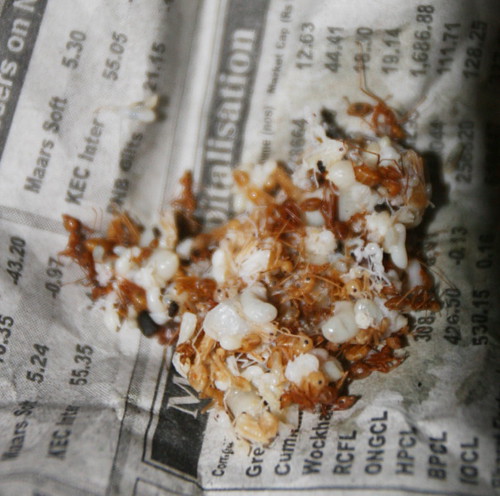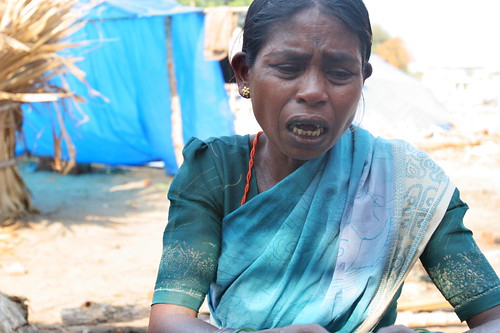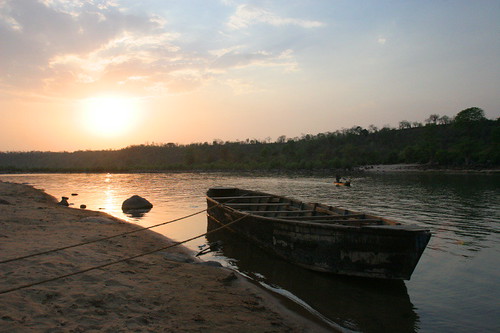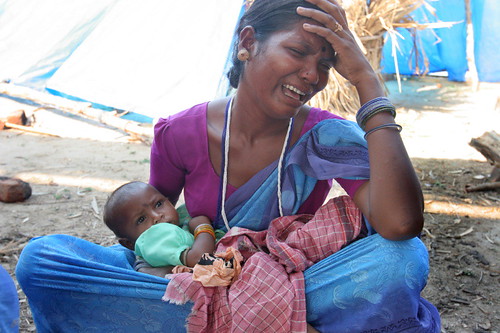
A tribal widow cries for her future. Her husband was killed in a mine blast set off by Maoist rebels.
By NEIL SAMSON KATZ
SPECIAL TO THE STAR LEDGER
PUBLISHED APRIL 24, 2006
Star Ledger Story Page 1
Star Ledger Story Page 2
CHHATTISGARH, India — The 78-kilometer road between Sukma and Konta is nearly deserted. Scores of villages, once bustling with tribal life, are now vacant. Across the rough orange and green terrain of the nearby forests, hundreds of other villages similarly have been abandoned. Tens of thousands of tribal people are simply gone.
This is not war-torn Afghanistan or Sudan. This is central India, where super sleek call centers and software factories have brought millions of poor into the modern middle class.
But the country’s drive to become a first world power has left many of its most vulnerable behind and frozen economic development across swaths of this vast country. At its most extreme and most dangerous — in remote forested areas — a four-decade-long rebellion has erupted into violent intimidation, exploitation of the young and dozens of murders.
To some, the rebellion is seen as a modern day tale of Robin Hood, with attacks on corrupt landlords and capitalists. To others, the rebels are now killing many of the same people they spent a generation fighting the government to protect: the poor villagers.
"They fooled the rural people saying that they would work for them," said Soyam Muka, a tribal teacher whose brother was killed by the rebels. "But instead they are torturing them. They are killing them."
Like revolutionaries in neighboring Nepal, the Indian rebels, called Naxalites, preach economic justice for the poor and violent confrontation with the government or anyone opposing their mission. Both uprisings, while largely independent of each other, take their cues from the playbook of Chinese revolutionary Mao Tse Dung.
Over the past 38 years the Naxalites have, by fits and starts, carved a "liberated zone" in a strip of heavily forested territory that stretches from India’s southern border with Sri Lanka to its northern border with Nepal.
There they hope to build the kernel of a communist state and, according to some security analysts, they are succeeding. One quarter of the country’s 602 counties are affected by varying degrees of Naxal violence and the Indian home ministry estimates the Naxalites have a force of at least 10,000. The fighters are flush with machine guns, explosives and land mines, according to police, much of it pilfered from poorly protected government stocks or manufactured in jungle factories.
Last week, Indian Prime Minister Manmohan Singh called Naxalism the country’s "single biggest internal security challenge."
"They violate all human rights. They attack security forces, policemen on duty, or police vehicles," said O.P. Rathor, the top police commander in the Naxal afflicted state of Chhattisgarh. "They have been targeting even the innocent civilian population."
Since 2004, when India’s largest Naxalite groups merged to create the Communist Party of India-Maoist, their attacks have become more daring and deadly, and more often directed at tribal people. Nearly 1,000 people were killed last year and more than half of the 282 people killed so far this were from the heavily tribal state of Chhattisgarh, according to the New Delhi-based Institute for Conflict Management.
"This is absolutely senseless killing," Rathor said. "They are just killing poor people. There is nothing of Communism in that."
Local media reports highlight a stunning series of attacks:
In November, hundreds of Naxalites stormed a jail in Bihar state, freed more than 300 prisoners and melted back into the forest.
Then in March, rebels captured a train carrying several hundred security personnel to protest the killing of a rebel commander.
And just last week, 14 Naxalites shot up a police station in Chhattisgarh, killing 11.
The violence is often blamed for the lack of development in the region.
"Because of Naxalism, there is a constant threat on the people over here," said Chhattisgarh chief minister Raman Singh, the top state official. "If the government tries to make roads, the Naxalites bomb the cars. If you try to develop these places the people are forced to leave them. Schools and hospitals, ashrams for children ... they have all stopped."
Some security analysts said the government’s neglect of tribal areas has made it easier for the Naxalites to spread their campaign.
“In the tribal areas there is only the notional presence of government and they are not concerned with tribal welfare,” said Ajai Sahni, executive director of the Institute for Conflict Management, a security think tank. “As far as the government is concerned the tribals are a nuisance.”
Along the road from Sukma to Konta the signs of development are sparse indeed.
Naxalite mine blasts have turned the road’s patchy pavement into crater-pocked moonscape. Last month near the refugee camp of Dornapal, a lone sandal lay in a field of broken glass 50 feet from a giant hole in the road, the gruesome remnants of a viscous mine blast that killed 30.
A few kilometers ahead, a small schoolhouse was turned to rubble. Elementary English books lay under bricks that were once the roof. The Naxalites destroyed the school because Indian police used it to quarter their forces, according to a local journalist.
Without infrastructure or education the tribals have lived off the forest for generations. Picking sal seeds, mawa or tendu, a leaf used to wrap Indian cigarettes, they eke out a meager existence.
Only now, according to local police, the Naxalites are extorting protection money from contractors that buy the tribal produce. Those who do not pay are beaten or murdered.
‘The Naxalites don’t allow us to build anything in the village. They stop us from farming. They stop us from digging wells," said Soya Muka, a tribal leader from Irrabor who fled his village after the Naxalites threatened to kill him. "If we don’t do that, how will we survive? How will we get our livelihood?"
In frustration, tribal leaders formed an anti-Naxal movement last June called Salwa Judum, or peace march. The government got behind it and promised security, training and guns. Relief camps were set up to house tribals who feared the Naxalites. Other tribals were “forced in” to the camps by Salwa Judum leaders eager to swell their ranks, said Sahni.
Whether by force or fear the camps quickly became overrun. Today, almost 50,000 tribals are housed in 26 camps across the Bastar and Dantewada districts of Chhattisgarh. In Konta, where more than 8,000 tribals are scrambling for shelter, Salwa Judum leaders said they don’t have materials to build fast enough.
Some refugees share houses with local villagers; the less fortunate make do in a dusty field on the outskirts of town, pitching tarps over wooden sticks.
Inside one large tent, Basanti Samaro cried out for her husband who died from injuries suffered in a mine blast weeks earlier. "My husband is no more. My husband has died," she wailed in her native Gondi tongue, "What will I do now? My life is no more."
Her husband, Sodi Somaro, was part of a caravan carrying Salwa Judum supporters from an anti-Naxal rally on Feb. 28 when a land mine tore through their truck. Then, according to witnesses, the rebels sprang from the forest and attacked anyone the mine didn’t already kill. The final toll was 30.
"They were killing us by knives, guns, and swords," said Musaki Ganga, a 25-year-old tribal who survived the attack. "You could hear the sounds of gunshots and screaming."
The tribals now know to stay off the roads. But it’s not clear the government-supported Konta camp is much safer. A barbed wire fence marks the camp’s perimeter but no one was guarding the entrance during a recent visit. The local police chief was sitting in front of his home with a machine gun on his lap but wouldn’t speak on the record for fear of his life.
Conditions in other camps are better.
The refugee camp in Dornapal seems well organized: tribals live communally under quickly built structures with tin roofs, and said they have enough food. A separate camp across the road houses several hundred suspected Naxal sympathizers and a few surrendered rebels. Armed security personnel are stationed next to the camps and rifle-toting police walk patrols with bow and arrow-armed tribals.
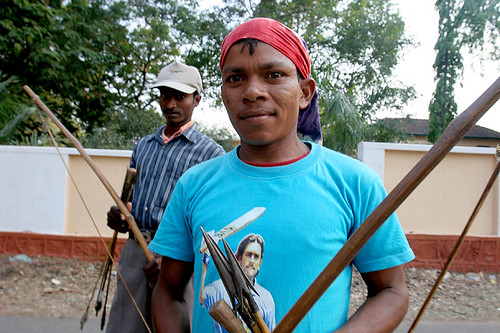
The government is training thousands of young tribals to become special police officers paying them $35 per month, a good wage here. But that is putting inexperienced tribals rather than the police on the front lines of the conflict.
The tribals, for the most part, are more than willing. In camps, the Salwa Judum leaders repeatedly had one message: "Give us guns and we will fight."
In Dornapal, many special officers are no more than teenagers who said they have received neither training nor wages. At night — armed with only bows and arrows and a patch of fabric denoting their deputized status — they must stand guard at the gates of the camp. They hope the well-armed rebels do not attack them.
"We only have bows and arrows. They can kill us from far away and we can do nothing," said R. P. Kushwa, a Salwa Judum leader in Dornapal.
In a March report, the New Delhi-based Asian Center for Human Rights claimed it has evidence that both the government-backed Salwa Judum and the Naxalites are training child soldiers.
The government doesn’t like to talk about children being trained to fight, and its officials preferred to talk about Salwa Judum being a peace movement reminiscent of Indian civil rights leader Mahatma Gandhi.
"This is the first time in history that, against such terrorism, there is a peace march," said Mahendra Karma, a powerful tribal politician who has backed Salwa Judum from the start. "If it is successful the whole world will get a new technique against terrorism."
Whether Salwa Judum remains a Gandhi-like enterprise, it has put the Naxalites in a politically tricky situation. Fighting the Salwa Judum means attacking the people they always have relied on for food, shelter, and support.
‘Until yesterday the Naxalites were talking against imperialists, capitalists, industrialists and monopolists," said Karma, who lost a brother to Naxal assassins. "But they have gone against their own cause. They have deviated from their principles. And they’re killing the people who are involved in Salwa Judum."
Back in Dornapal, the tribals are less philosophical about their future.
"We are not afraid," said Soimarra, a camp leader who, like many tribals, uses only one name. "Now that we have stood up against them we will destroy them and we won’t stop in between, because if we stop they will destroy us first."
Neil Samson Katz is a freelance writer and photographer. He spent the last two months working and traveling in India. He may be reached at neil@neilkatzphoto.com.

